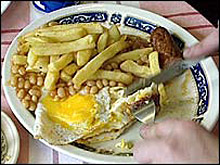 |
 |
 |
 Health & Beauty | November 2005 Health & Beauty | November 2005  
'Taste Bud' for Fatty Foods Found
 Wire services Wire services


| | The taste receptor studied responds to foods rich in fat. |
Scientists have found that the tongue has taste receptors for fat, which might explain why we like fried foods.

Conventionally, experts have thought that the tongue detects five tastes - sweet, salty, sour, bitter and umami taste for protein rich foods.

But tests on rodents showed a receptor on the tongue tastes fat - it is not known if it is the same for humans.

The work by French researchers from the University of Burgundy appears in the Journal of Clinical Investigation.

Taste for fat

Investigator Philippe Besnard and his team believe the CD36 receptors that they found were important for evolutionary reasons - to ensure animals ate a high energy diet when foods were scarce.

But in the current Western climate, where food is in abundance and about 40% of the energy we consume comes from fat, this may be a disadvantage for the waistline if the same receptor is present in humans.

The CD36 receptor is already known to exist in many tissues involved in fat storage.

To see whether the receptor might be the tongue's fat detector, the researchers studied rats and mice that were normal or had the gene for CD36 "knocked out" so that the receptor no longer worked.

The normal rodents showed a preference for fatty foods when offered them, yet the knock out mice did not.

Also, when the researchers put a fatty liquid onto the tongues of the normal rats, this triggered a release of fat-processing substances from the digestive organs. This reaction did not happen in the knock out mice.

Professor Nada Abumrad of Washington University School of Medicine in St Louis, the US, said in an accompanying commentary in the same medical journal: "As we gain more information regarding the function of this receptor, we may be able to devise better strategies to address the addictive potential of dietary fat."

She said people varied in their ability to taste different foods - some barely perceive one or more flavours, while others are super-tasters and find some flavours too intense.

This might explain why some people are more prone to crave certain foods than others and even why some people put on weight, she said.

"There is evidence that obesity may be associated with an abnormal brain response to the sensory perception of a meal."

Professor Tim Jacob, an expert in smell and taste research at Cardiff University, said conclusive evidence was still needed to say that the CD36 receptor was a true taste bud for fat in the same way that there are taste buds for sweet and sour because it did not appear to work in precisely the same way as these other taste buds.

He also questioned whether fat was a "taste" or an oral sensation.

"Fats taste because of the interesting molecules that are fat soluble - marbled beef with fat streaks is much more tasty than lean beef because all the interesting flavours from the animal's diet dissolve in the fat and are retained," he said. | 
 | |
 |



